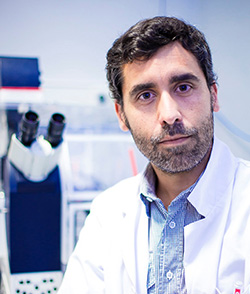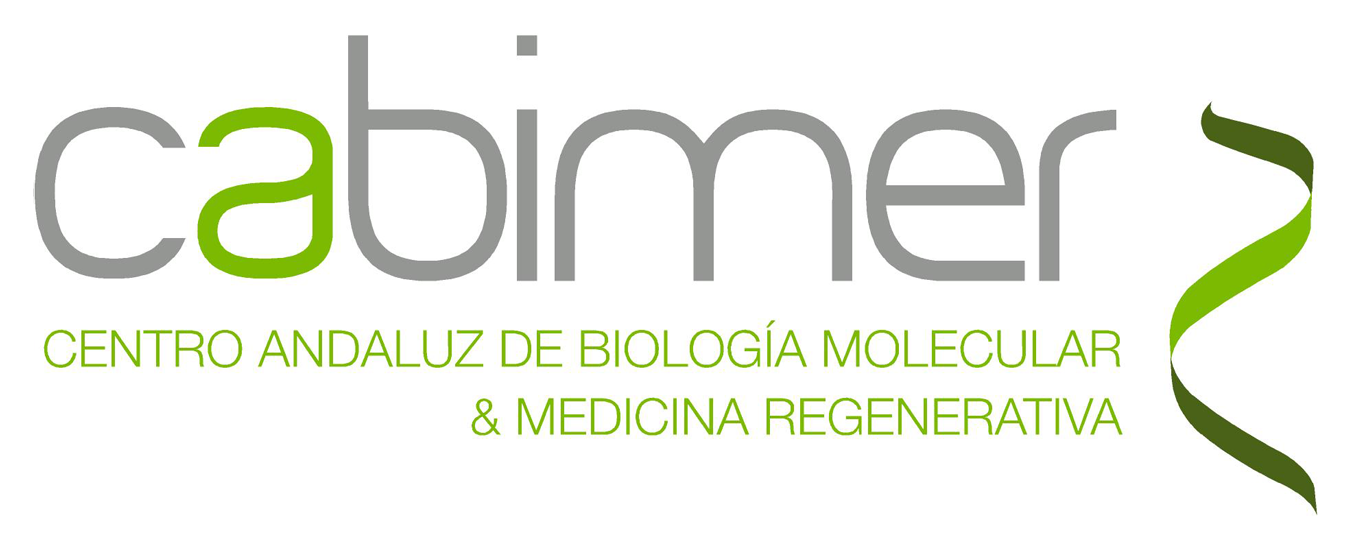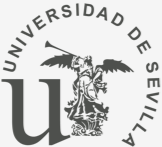e-mail: fernando.balestra@cabimer.es

We are interested in understanding centriole structure, assembly, and function in human cells. Specifically, we want to reveal the molecular mechanism regulating centriole number control and the components and pathways involved in the crosstalk between the centriole and the DNA damage response. Centrosomes are the main microtubule-organizing centers of animal cells. Extremely well conserved across evolution, they are composed of a pair of centrioles surrounded by a cloud of pericentriolar material. Proteomic and bioinformatics analysis have identified hundreds of proteins that localize to the centriole/centrosome, however, the function of the vast majority of these proteins remains a mystery.
In addition to their role in organizing the MT cytoskeleton during interphase, the centrosomes/centrioles as MTOCs are also key components of the mitotic spindle. In non-dividing cells, the centrioles (known at this stage as basal bodies) are essential for the formation of the primary cilia and flagella. Furthermore, centrioles also play roles as signaling platforms in dividing cells coordinating several cellular processes. In summary, centrioles/centrosomes are key players in chromosome segregation, spindle orientation, cell migration, cell polarity and cell signaling. Remarkably, patient’s cells from many types of cancers have in common the feature of bearing centriole abnormalities or extra number of centrioles, which have been proposed as the molecular root of these pathologies. We believe that further understanding the molecular mechanism regulating centriole number homeostasis and centriole signaling will contribute to identify pathways and molecular targets to battle cancer.
Main Research Lines:
- Centriole number control: We are trying to reveal new mechanisms involved in the regulation of the canonical centriole duplication pathway or alternatively restricting centriole assembly by other centriole assembly pathways.
- Centriole and DNA damage response: We are trying to unravel the connection between centrosomes and the DNA damage response
- Centriole assembly: We are characterizing the role of identified proteins involved in the canonical centriole assembly pathway.
- Centriole positioning: We have performed a genome-wide analysis to identify regulators of centriole position in human cells. We are focus on those candidates involved in the connection between the centrosomes and the nuclear surface.
Rodríguez-Real G, Domínguez-Calvo A, Prados-Carvajal R, Bayona-Feliú A, Gomes-Pereira S, Balestra FR*, Huertas P. Centriolar subdistal appendages promote double-strand break repair through homologous recombination.EMBO Rep. 2023 Oct 9;24(10):e56724. doi: 10.15252/embr.202256724. * Corresponding autor.
Gönczy P, Balestra FR. Sperm-contributed centrioles segregate stochastically into blastomeres of 4-cell stage Caenorhabditis elegans embryos. Genetics. 2023 May 4;224(1):iyad048. doi: 10.1093/genetics/iyad048.
Pérez D, Moyá ML, Bautista M, León R, Molina-Márquez A, Vila M, Romero-Azogil L, Benito E, de Gracia García-Martín M, Moreno-Gordillo P, Rosado IV, Balestra FR, Huertas P, López-López M, López-Cornejo P. A novel biocompatible polymer derived from D-mannitol used as a vector in the field of genetic engineering of eukaryotic cells. Colloids Surf B Biointerfaces. 2023 Apr;224:113219. doi: 10.1016/j.colsurfb.2023.113219.
Domínguez-Calvo A., Gönczy P., Holland A. J. and Balestra F. R*. TRIM37: a critical orchestrator of centrosome function. Cell Cycle, 2021 Dec;20(23):2443-2451. doi: 10.1080/15384101.2021.1988289. *Corresponding author.
Balestra F. R.*, Domínguez-Calvo A., Wolf B., Buff A., Averink T., Lipsanen-Nyman M., Busso C., Huertas P., M. Ríos M. R., Gönczy P.*. TRIM37 prevents formation of centriolar protein assemblies by regulating Centrobin stability. Elife. 2021 Jan 25;10:e62640. doi: 10.7554/eLife.62640. *Co-corresponding author.
Lebrón JA, López-López M, García-Calderón CB, V Rosado I, Balestra FR, Huertas P, Rodik RV, Kalchenko VI, Bernal E, Moyá ML, López-Cornejo P, Ostos FJ. Multivalent Calixarene-Based Liposomes as Platforms for Gene and Drug Delivery. Pharmaceutics. 2021 Aug 12;13(8):1250. doi: 10.3390/pharmaceutics13081250.
Pérez-Alfonso D., López-López M., López-Cornejo P., Romero-Azogil L., Benito E., García-Martín M. G., García-Calderón C. B., Iván V. Rosado I. V., Fernando R. Balestra F. R., Huertas P., García-Calderón M. and Moyá M. L. Properties of polyplexes formed between a cationic polymer derived from l-arabinitol and nucleic acids. New J. Chem., 2021, 45, 10098-10108. DOI: 10.1039/D1NJ00606A.
Jimeno S, Balestra F. R., Huertas P. The Emerging Role of RNA Modifications in DNA Double-Strand Break Repair. Front Mol Biosci. 2021 Apr 29;8:664872. doi: 10.3389/fmolb.2021.664872
Checa-Rodríguez C., Cepeda-García C., Ramón J., López-Saavedra A., Balestra F. R., Domínguez-Sánchez M. S., Gómez-Cabello D. and Huertas P. Methylation of the central transcriptional regulator KLF4 by PRMT5 is required for DNA end resection and recombination. DNA Repair. 2020. Vol 94, pp. 1 – 11.
Lebrón J. A., Ostos F. J., López-López M., Moyá M. L., Sales C., García E., García-Calderón C. B., García-Calderón M., Peña-Gómez M. J., Rosado I. V., Balestra F. R., Huertas P. and López-Cornejo P. Metallo-Liposomes of Ruthenium Used as Promising Vectors of Genetic Material. Pharmaceutics, 2020. 12 – 5, pp. 1 -13.
Gavilan M.P., Gandolfo p., Balestra F. R., Arias F., y Ríos R. M. 2018. The dual role of the centrosome in organizing the microtubule network in interphase. EMBO Rep. 2018 Nov;19(11).
Wolf B, Balestra F. R., Spahr A, Gönczy P. ZYG-1 promotes limited centriole amplification in the C. elegans seam lineage . Developmental Biology. 2018. 434-2, pp.221-230.
Balestra, F. R.; von Tobel, L.; Gönczy, P. Paternally contributed centrioles exhibit exceptional persistence in C. elegans embryos. Cell research. 2015. 25-5, pp.642-646. ISSN 1748-7838.
von Tobel, L., Mikeladze-Dvali, T., Delattre, M., Balestra, F.R., Blanchoud, S., Finger, S., Knott, G., Müller-Reichert, T., Gönczy, P. SAS-1 is a C2 domain protein critical for centriole integrity in C. elegans. 2014. PLoS genetics. 10-11, pp.e1004777. ISSN 1553-7404.
Balestra, F. R. y Gönczy, P. Multiciliogenesis: multicilin directs transcriptional activation of centriole formation. 2014. Current biology : CB. 24-16, pp.R746. ISSN 1879-0445.
Balestra, F. R., Strnad, P., Flückiger, I. y Gönczy, P. Discovering regulators of centriole biogenesis through siRNA-based functional genomics in human cells. 2013. Developmental cell. 25-6, pp.555-626. ISSN 1878-1551.
Balestra F. R. and Pierre Gönczy. 2013. Centriole Screen.
Publicación de datos en Applicación web.
Kitagawa, D., Kohlmaier, G., Keller, D., Strnad, P., Balestra, F. R., Flückiger, I., Gönczy, P. Spindle positioning in human cells relies on proper centriole formation and on the microcephaly proteins CPAP and STIL. 2011. Journal of cell science. 124-Pt 22, pp.3884-3977. ISSN 1477-9137.
Balestra, F. R. y Jimenez, J. A G2-phase microtubule-damage response in fission yeast. 2008. Genetics. 180-4, pp.2073-2153. ISSN 0016-6731.






